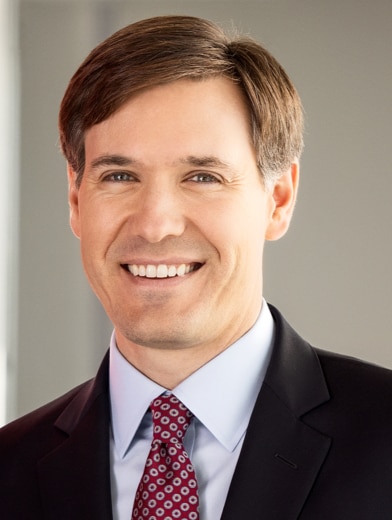Expert insight
Consumer spending could push Fed higher
April 03, 2023
Look for consumer spending to play a pivotal role in the U.S. economy in the year ahead. New research from a team led by Bob Behal, co-head of structured product investments in Vanguard Fixed Income Group, and Josh Hirt, U.S. senior economist in Vanguard Investment Strategy Group, suggests that the consumer—bolstered by pandemic-related reduced consumption, government stimulus, and higher wages—has the capacity to continue spending.
Behal and Hirt spoke recently about their research and its implications for the economy.
You expect U.S. consumer spending to remain resilient despite high inflation, falling real wages, and an increased use of credit. What is the thinking behind that conclusion?
Hirt: Those headwinds have led some to question the ongoing health of the consumer and what that could mean for the economy, given that consumer spending generates roughly 70% of U.S. GDP.
Our motivation in conducting this research was to stress-test the consumer runway, given the push and pull from a significant buildup in savings and the reduced purchasing power from inflation. We found that, given a range of potential economic environments ahead and considering disparities across income levels, the consumer overall is well-positioned.
Under our base case, in which the labor market softens moderately and inflation ends 2023 at around 3%, wage gains and savings drawdown could more than adequately fund consumer spending at current levels through 2023. Only in 2024 do we see excess savings being exhausted, especially under the more pessimistic assumptions about economic conditions.
Consumers have capacity to keep spending into 2024
Remaining excess savings levels under various economic scenarios

Notes: Our assessment of remaining excess savings is an average of our estimates employing two methods: a bottom-up approach that subtracts cohort level income from expenditures, and a top-down approach that measures the accumulated increase in savings over cycle-adjusted neutral levels. The four economic scenarios are defined at the year-end 2023 levels of unemployment and core CPI inflation. Upside: unemployment at 4%, inflation at 2.3%. Baseline: unemployment at 4.5%–5%, inflation at 3%. Downside: unemployment at 5%, inflation at 5.1%. Extended downside: unemployment at 6%, inflation at 6.9%.
Sources: Vanguard calculations, based on data from the U.S. Bureau of Labor Statistics, the U.S. Bureau of Economic Analysis, and Refinitiv.
Behal: I would note there’s been a pickup in credit use over the past year. But this constitutes more of a normalization back toward pre-COVID trends than an alarming escalation. As a percentage of GDP, consumer credit remains near historic lows. Furthermore, the trend in savings rate and consumption in 2022 is evidence that consumers have largely been funding their spending by drawing from savings. All in, consumer balance sheets are still very healthy.
Your work suggests that more persistent consumption could push the Federal Reserve to raise interest rates beyond current expectations. What would the implications be of this assessment?
Hirt: The Fed is aiming to raise the policy rate to levels that will sufficiently slow the economy and cool inflation. Continued solid spending risks keeping inflation higher for longer, requiring higher interest rates to bring it back down to acceptable levels. Our outlook anticipates the Fed taking its policy rate target to 5.5%–5.75%, but we estimate that continued strength in the economy could warrant it going half a percentage point beyond that.
What are the implications of sustained consumer spending for businesses?
Behal: It would have implications across the economy, but companies operating in consumer-centric sectors such as lending, retail, air travel, lodging, entertainment, and restaurants would likely benefit in particular.
The direction of the economy will depend a lot on the stickiness of inflation and employment strength, but a healthy consumer should support demand and therefore possibly slow the rate of deterioration in corporate fundamentals that is occurring as interest rates rise.
Continued trend spending risks pushing the Fed higher

Notes: Data for quarterly actual consumption growth are from the fourth quarter of 2021 through the first quarter of 2023 (the Q1 2023 actual consumption bar is a Vanguard estimate based on preliminary data). Vanguard’s baseline quarterly consumption growth forecasts are from Q4 2021 through Q4 2024. The trend line represents the quarterly growth rate historical average from 2017 through 2019.
Sources: Vanguard calculations, based on data from Refinitiv.
Your work specifically looked at different cohorts of consumers to assess elements hidden by the larger group. What did that uncover?
Behal: In testing the sensitivity of consumer savings balances to income and inflationary pressures across various scenarios, we found that certain income cohorts may be experiencing more stress than others. Consumers in the bottom two income quintiles have exhausted most of their savings built up since the start of the pandemic. The top three income quintiles, however, still appear to have reasonable savings buffers and wage gains to tolerate stress through 2023 and into 2024. Those top-earning quintiles account for approximately 80% of total consumption.
How does Vanguard consider a more resilient consumer in the context of recent strong economic data?
Hirt: There aren’t many parallels in history to guide how households will use savings buffers of this magnitude or how they might modify their spending when faced with higher prices. Our work, though, suggests that households have the capacity to keep spending, and it would be somewhat atypical to see a proactive cutback as long as the labor market remains strong. Recent data have seen a degree of reacceleration, adding to upside risk. (Vanguard recently raised its forecast for 2023 U.S. GDP growth.) We continue, though, to expect as a baseline a mild downturn in the economy later in 2023 as the effects from policy rate increases over the last year reach their full effect.
Over the next year in particular, consumer spending will be a key factor in setting the U.S. economy’s direction.
Related links:
- Strong data could push recession down the road (article, issued February 2023)
- Our investment and economic outlook, March 2023 (article, issued March 2023)
- China’s economic rebound lowers the odds of a global recession (article, issued February 2023)
- One year on, Europe’s energy crisis is far from over (article, issued February 2023)
Contributors

Bob Behal
